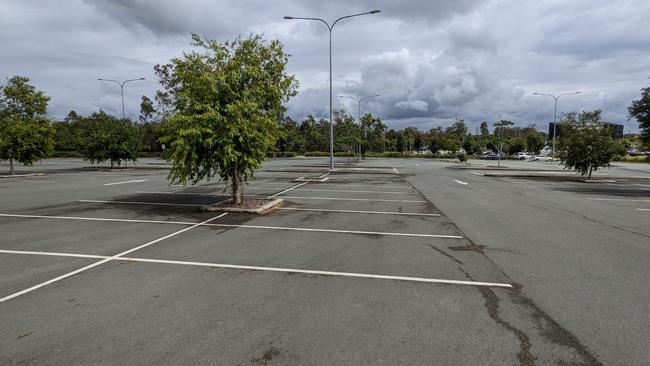Gold Coast’s quietest car park raises questions about success of light rail
A car park built to serve commuters using the light rail is lying half empty most mornings. Here’s the big mistake that was made.
Gold Coast
Don't miss out on the headlines from Gold Coast. Followed categories will be added to My News.
Nine AM on a Monday morning. Workers are at their desks. The commuter peak has just passed.
Yet one of the biggest commuter car parks on the Gold Coast, serving its gleaming new public transport system, lies well more than half empty.
There are cars clustered nearer to the stop, but at the southern end of the park and ride facility at the Parkwood light rail station, you could happily set up a basketball court – maybe ten – and wouldn’t bother anyone.

It’s a strange, incongruous sight, especially given the context in which it is located.
This vast expanse of empty tarmac lies just 200 metres from the M1 at Gaven.
At the same time as your columnist was strolling in glorious solitude around the car park, vehicles were at a near standstill in the motorway’s overloaded southbound lanes.
A little further up the road, at the Gold Coast University Hospital, motorists were doing laps of its car park in hunt of one of the few remaining spaces.
At least some of those people would be spared these indignities if they availed of the free parking at Parkwood and hopped on a tram.
The fact they choose not to appears to speak volumes about the view of Gold Coasters towards public transport.
Figures revealed in the Bulletin this week also appear to cast doubt on the popularity of the light rail system.
Despite heavy investment by the state and federal governments to build the Gold Coast line, its patronage numbers are well below official targets.
They are also 16 per cent below pre-Covid levels, despite the end of pandemic restrictions.

Does all of the above mean the light rail is a costly failure? It depends how you look at it.
It has always been clear that the light rail was popular with tourists. And tourist numbers have also yet to recover to their pre-pandemic levels.
International visitor numbers are still a fraction of what they were in 2019. Even domestic numbers remain weaker.
Tourism & Events Queensland figures show 15.3 per cent less domestic visitors came to the Gold Coast in the second quarter of this year compared to the same time in 2019.
As tourist numbers improve, expect the light rail numbers to tick up too.

Having an efficient public transport system valued by visitors can hardly be seen as a negative in a place like the Gold Coast.
If you believe that alone makes it worth the price tag then the proposed extension to the airport makes obvious sense, despite the recent disappointing patronage figures.
But the light rail was always pitched as something more, as a means of encouraging Gold Coasters out of their car and onto public transport.
The scene at the Parkwood car park each weekday morning suggests this ambition is far from being fulfilled.
However it may be that the car park, and indeed this section of the line, is just poorly located.
A little up the road at Helensvale station, which notably is also served by heavy rail, there are regularly cars parked on grass verges again. Helensvale has 1290 spaces, Parkwood 1005.
By choosing to go by Parkwood for stage two, planners opted for the most efficient possible route – it takes just 11 minutes to travel from Helensvale to the hospital – but one that is pretty sparsely populated and passes through no major economic centres.
If they’d gone for the considerably more difficult Harbour Town route, it might be a different story.
Lessons must be learned for any future extensions. Light rail is expensive and building it disruptive in many ways – dozens of trees, for example, were felled to make way for the barely-used Parkwood car park.
The trams themselves are comfortable and clean, the journeys almost always pleasant. But better planning will surely be needed if more people are to hop aboard.
More Coverage
Originally published as Gold Coast’s quietest car park raises questions about success of light rail





